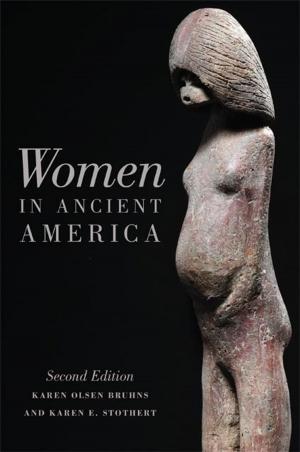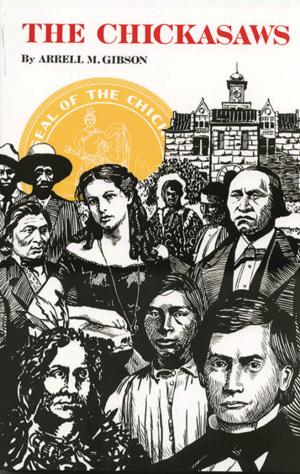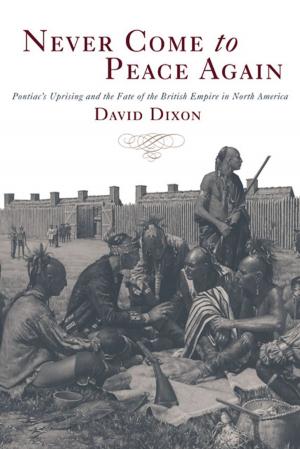Lakota Performers in Europe
Their Culture and the Artifacts They Left Behind
Nonfiction, Social & Cultural Studies, Social Science, Cultural Studies, Native American Studies, History, Americas, Native American, United States, 19th Century| Author: | Steve Friesen, François Chladiuk | ISBN: | 9780806158266 |
| Publisher: | University of Oklahoma Press | Publication: | June 8, 2017 |
| Imprint: | University of Oklahoma Press | Language: | English |
| Author: | Steve Friesen, François Chladiuk |
| ISBN: | 9780806158266 |
| Publisher: | University of Oklahoma Press |
| Publication: | June 8, 2017 |
| Imprint: | University of Oklahoma Press |
| Language: | English |
From April to November 1935 in Belgium, fifteen Lakotas enacted their culture on a world stage. Wearing beaded moccasins and eagle-feather headdresses, they set up tepees, danced, and demonstrated marksmanship and horse taming for the twenty million visitors to the Brussels International Exposition, a grand event similar to a world’s fair. The performers then turned homeward, leaving behind 157 pieces of Lakota culture that they had used in the exposition, ranging from costumery to weaponry. In Lakota Performers in Europe, author Steve Friesen tells the story of these artifacts, forgotten until recently, and of the Lakota performers who used them.
The 1935 exposition marked a culmination of more than a century of European travel by American Indian performers, and of Europeans’ fascination with Native culture, fanned in part by William F. “Buffalo Bill” Cody’s Wild West from the late 1800s through 1913. Although European newspaper reports often stereotyped Native performers as “savages,” American Indians were drawn to participate by the opportunity to practice traditional aspects of their culture, earn better wages, and see the world. When the organizers of the 1935 exposition wanted to include an American Indian village, Sam Lone Bear, Thomas and Sallie Stabber, Joe Little Moon, and other Lakotas were eager to participate. By doing this, they were able to preserve their culture and influence European attitudes toward it. Friesen narrates these Lakotas' experiences abroad. In the process, he also tells the tale of collector François Chladiuk, who acquired the Lakotas’ artifacts in 2004. More than 300 color and black-and-white photographs document the collection of items used by the performers during the exposition.
Friesen portrays a time when American Indians—who would not long after return to Europe as allies and liberators in military garb—appeared on the international stage as ambassadors of the American West. Lakota Performers in Europe offers a complex view of a vibrant culture practiced and preserved against tremendous odds.
From April to November 1935 in Belgium, fifteen Lakotas enacted their culture on a world stage. Wearing beaded moccasins and eagle-feather headdresses, they set up tepees, danced, and demonstrated marksmanship and horse taming for the twenty million visitors to the Brussels International Exposition, a grand event similar to a world’s fair. The performers then turned homeward, leaving behind 157 pieces of Lakota culture that they had used in the exposition, ranging from costumery to weaponry. In Lakota Performers in Europe, author Steve Friesen tells the story of these artifacts, forgotten until recently, and of the Lakota performers who used them.
The 1935 exposition marked a culmination of more than a century of European travel by American Indian performers, and of Europeans’ fascination with Native culture, fanned in part by William F. “Buffalo Bill” Cody’s Wild West from the late 1800s through 1913. Although European newspaper reports often stereotyped Native performers as “savages,” American Indians were drawn to participate by the opportunity to practice traditional aspects of their culture, earn better wages, and see the world. When the organizers of the 1935 exposition wanted to include an American Indian village, Sam Lone Bear, Thomas and Sallie Stabber, Joe Little Moon, and other Lakotas were eager to participate. By doing this, they were able to preserve their culture and influence European attitudes toward it. Friesen narrates these Lakotas' experiences abroad. In the process, he also tells the tale of collector François Chladiuk, who acquired the Lakotas’ artifacts in 2004. More than 300 color and black-and-white photographs document the collection of items used by the performers during the exposition.
Friesen portrays a time when American Indians—who would not long after return to Europe as allies and liberators in military garb—appeared on the international stage as ambassadors of the American West. Lakota Performers in Europe offers a complex view of a vibrant culture practiced and preserved against tremendous odds.















